Critical Essay: The Patent System and Robot Inventors
VerifiedAdded on 2021/10/04
|6
|1283
|137
Essay
AI Summary
This essay explores the evolving relationship between robot inventors and the patent system in the context of artificial intelligence (AI). It begins by highlighting AI's transformative potential and its impact on various industries, including the rise of robot inventions. The essay then delves into the challenges and opportunities presented by the patent system for AI-driven innovations, discussing the need for patent laws to adapt to the rapid advancements in technology. It examines the existing patent system's limitations, particularly in addressing inventions created by AI, and considers the potential benefits and drawbacks of granting patent rights to such inventions. The essay emphasizes the importance of balancing innovation with ethical and socio-economic considerations, advocating for a balanced approach that promotes innovation while mitigating potential negative impacts. It concludes by suggesting the need for careful evaluation of patent-eligible subject matters and the development of strategies for patenting AI-build inventions, ultimately aiming to ensure the patent system supports robot inventors and fosters a future where AI innovation thrives without causing destruction. The essay uses multiple sources to support its arguments, including the World Economic Forum and various academic publications.
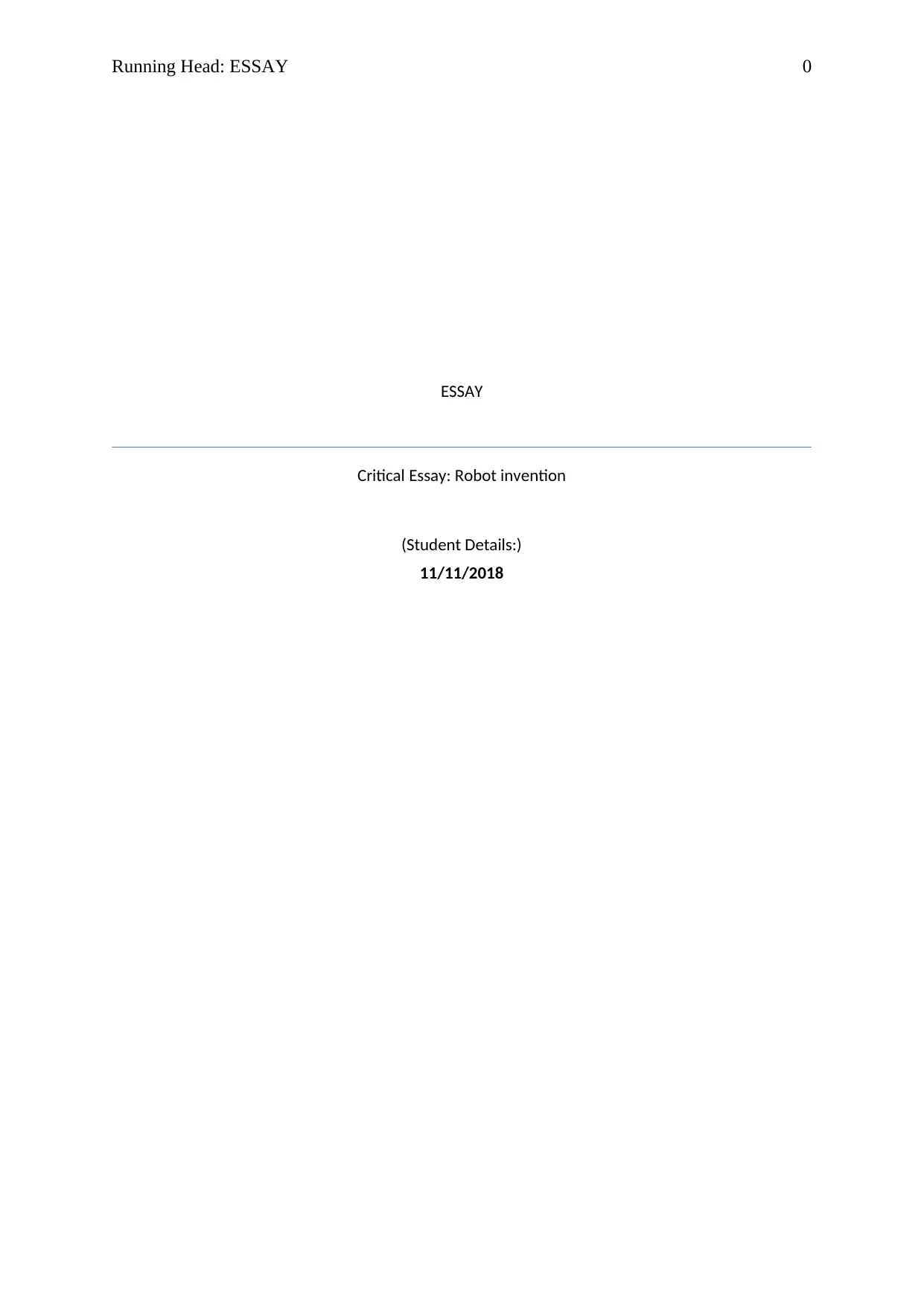
Running Head: ESSAY 0
ESSAY
Critical Essay: Robot invention
(Student Details:)
11/11/2018
ESSAY
Critical Essay: Robot invention
(Student Details:)
11/11/2018
Paraphrase This Document
Need a fresh take? Get an instant paraphrase of this document with our AI Paraphraser

Essay 1
Contents
Robot inventors are on the rise. But are they welcomed by the patent system?........................2
Introduction................................................................................................................................2
Robot Inventors and Patent System...........................................................................................2
Conclusion..................................................................................................................................3
References..................................................................................................................................4
Contents
Robot inventors are on the rise. But are they welcomed by the patent system?........................2
Introduction................................................................................................................................2
Robot Inventors and Patent System...........................................................................................2
Conclusion..................................................................................................................................3
References..................................................................................................................................4
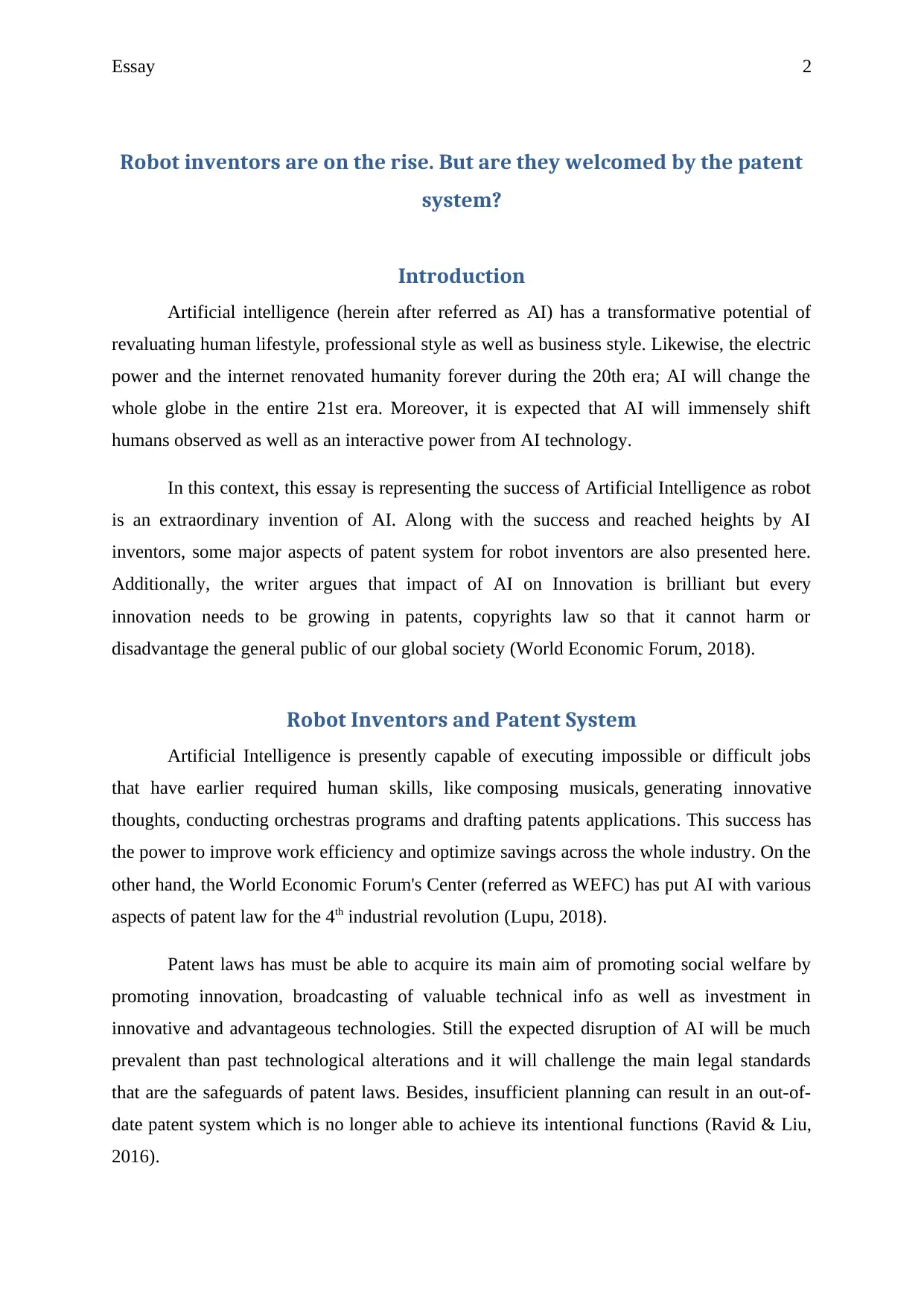
Essay 2
Robot inventors are on the rise. But are they welcomed by the patent
system?
Introduction
Artificial intelligence (herein after referred as AI) has a transformative potential of
revaluating human lifestyle, professional style as well as business style. Likewise, the electric
power and the internet renovated humanity forever during the 20th era; AI will change the
whole globe in the entire 21st era. Moreover, it is expected that AI will immensely shift
humans observed as well as an interactive power from AI technology.
In this context, this essay is representing the success of Artificial Intelligence as robot
is an extraordinary invention of AI. Along with the success and reached heights by AI
inventors, some major aspects of patent system for robot inventors are also presented here.
Additionally, the writer argues that impact of AI on Innovation is brilliant but every
innovation needs to be growing in patents, copyrights law so that it cannot harm or
disadvantage the general public of our global society (World Economic Forum, 2018).
Robot Inventors and Patent System
Artificial Intelligence is presently capable of executing impossible or difficult jobs
that have earlier required human skills, like composing musicals, generating innovative
thoughts, conducting orchestras programs and drafting patents applications. This success has
the power to improve work efficiency and optimize savings across the whole industry. On the
other hand, the World Economic Forum's Center (referred as WEFC) has put AI with various
aspects of patent law for the 4th industrial revolution (Lupu, 2018).
Patent laws has must be able to acquire its main aim of promoting social welfare by
promoting innovation, broadcasting of valuable technical info as well as investment in
innovative and advantageous technologies. Still the expected disruption of AI will be much
prevalent than past technological alterations and it will challenge the main legal standards
that are the safeguards of patent laws. Besides, insufficient planning can result in an out-of-
date patent system which is no longer able to achieve its intentional functions (Ravid & Liu,
2016).
Robot inventors are on the rise. But are they welcomed by the patent
system?
Introduction
Artificial intelligence (herein after referred as AI) has a transformative potential of
revaluating human lifestyle, professional style as well as business style. Likewise, the electric
power and the internet renovated humanity forever during the 20th era; AI will change the
whole globe in the entire 21st era. Moreover, it is expected that AI will immensely shift
humans observed as well as an interactive power from AI technology.
In this context, this essay is representing the success of Artificial Intelligence as robot
is an extraordinary invention of AI. Along with the success and reached heights by AI
inventors, some major aspects of patent system for robot inventors are also presented here.
Additionally, the writer argues that impact of AI on Innovation is brilliant but every
innovation needs to be growing in patents, copyrights law so that it cannot harm or
disadvantage the general public of our global society (World Economic Forum, 2018).
Robot Inventors and Patent System
Artificial Intelligence is presently capable of executing impossible or difficult jobs
that have earlier required human skills, like composing musicals, generating innovative
thoughts, conducting orchestras programs and drafting patents applications. This success has
the power to improve work efficiency and optimize savings across the whole industry. On the
other hand, the World Economic Forum's Center (referred as WEFC) has put AI with various
aspects of patent law for the 4th industrial revolution (Lupu, 2018).
Patent laws has must be able to acquire its main aim of promoting social welfare by
promoting innovation, broadcasting of valuable technical info as well as investment in
innovative and advantageous technologies. Still the expected disruption of AI will be much
prevalent than past technological alterations and it will challenge the main legal standards
that are the safeguards of patent laws. Besides, insufficient planning can result in an out-of-
date patent system which is no longer able to achieve its intentional functions (Ravid & Liu,
2016).
⊘ This is a preview!⊘
Do you want full access?
Subscribe today to unlock all pages.

Trusted by 1+ million students worldwide
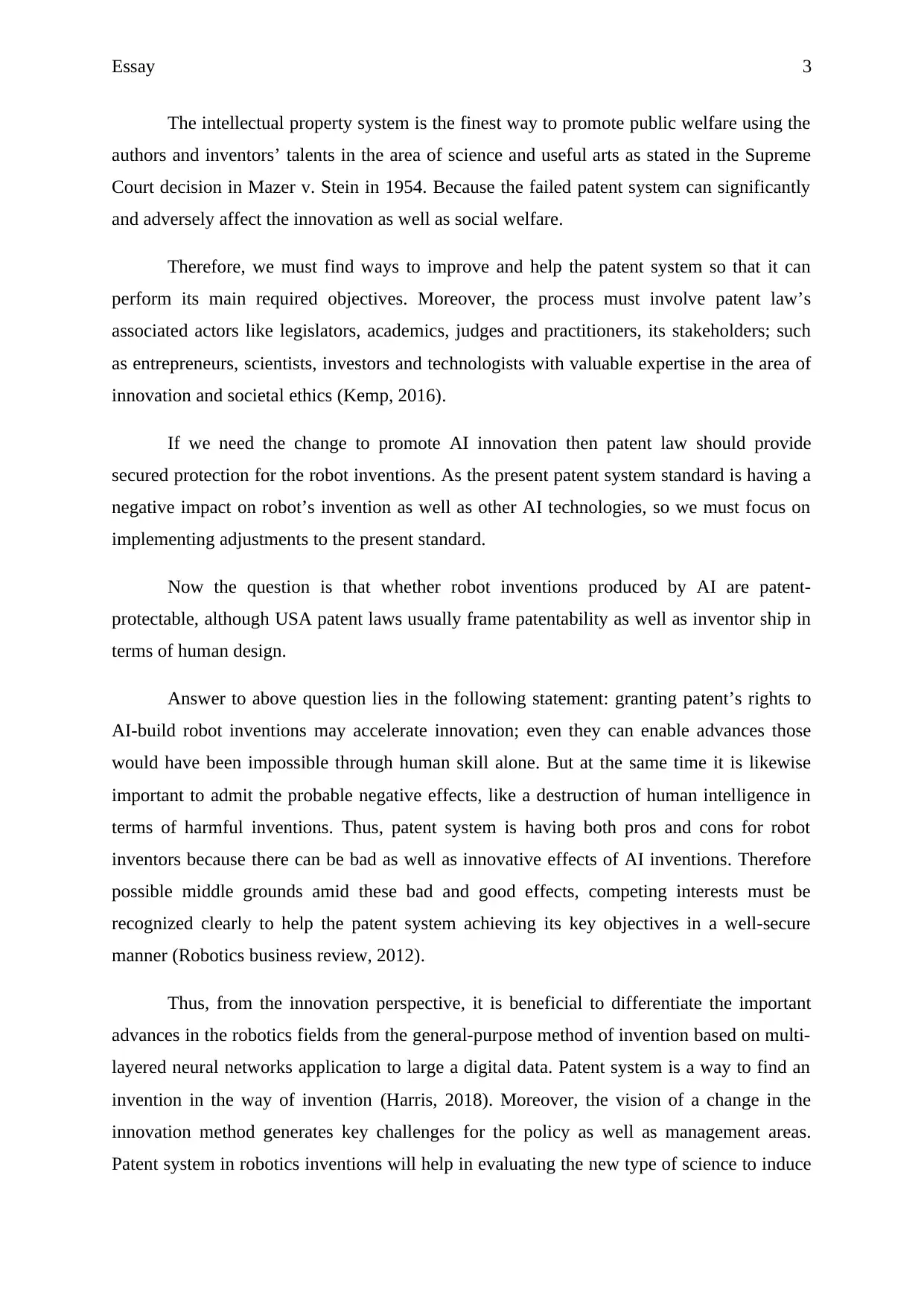
Essay 3
The intellectual property system is the finest way to promote public welfare using the
authors and inventors’ talents in the area of science and useful arts as stated in the Supreme
Court decision in Mazer v. Stein in 1954. Because the failed patent system can significantly
and adversely affect the innovation as well as social welfare.
Therefore, we must find ways to improve and help the patent system so that it can
perform its main required objectives. Moreover, the process must involve patent law’s
associated actors like legislators, academics, judges and practitioners, its stakeholders; such
as entrepreneurs, scientists, investors and technologists with valuable expertise in the area of
innovation and societal ethics (Kemp, 2016).
If we need the change to promote AI innovation then patent law should provide
secured protection for the robot inventions. As the present patent system standard is having a
negative impact on robot’s invention as well as other AI technologies, so we must focus on
implementing adjustments to the present standard.
Now the question is that whether robot inventions produced by AI are patent-
protectable, although USA patent laws usually frame patentability as well as inventor ship in
terms of human design.
Answer to above question lies in the following statement: granting patent’s rights to
AI-build robot inventions may accelerate innovation; even they can enable advances those
would have been impossible through human skill alone. But at the same time it is likewise
important to admit the probable negative effects, like a destruction of human intelligence in
terms of harmful inventions. Thus, patent system is having both pros and cons for robot
inventors because there can be bad as well as innovative effects of AI inventions. Therefore
possible middle grounds amid these bad and good effects, competing interests must be
recognized clearly to help the patent system achieving its key objectives in a well-secure
manner (Robotics business review, 2012).
Thus, from the innovation perspective, it is beneficial to differentiate the important
advances in the robotics fields from the general-purpose method of invention based on multi-
layered neural networks application to large a digital data. Patent system is a way to find an
invention in the way of invention (Harris, 2018). Moreover, the vision of a change in the
innovation method generates key challenges for the policy as well as management areas.
Patent system in robotics inventions will help in evaluating the new type of science to induce
The intellectual property system is the finest way to promote public welfare using the
authors and inventors’ talents in the area of science and useful arts as stated in the Supreme
Court decision in Mazer v. Stein in 1954. Because the failed patent system can significantly
and adversely affect the innovation as well as social welfare.
Therefore, we must find ways to improve and help the patent system so that it can
perform its main required objectives. Moreover, the process must involve patent law’s
associated actors like legislators, academics, judges and practitioners, its stakeholders; such
as entrepreneurs, scientists, investors and technologists with valuable expertise in the area of
innovation and societal ethics (Kemp, 2016).
If we need the change to promote AI innovation then patent law should provide
secured protection for the robot inventions. As the present patent system standard is having a
negative impact on robot’s invention as well as other AI technologies, so we must focus on
implementing adjustments to the present standard.
Now the question is that whether robot inventions produced by AI are patent-
protectable, although USA patent laws usually frame patentability as well as inventor ship in
terms of human design.
Answer to above question lies in the following statement: granting patent’s rights to
AI-build robot inventions may accelerate innovation; even they can enable advances those
would have been impossible through human skill alone. But at the same time it is likewise
important to admit the probable negative effects, like a destruction of human intelligence in
terms of harmful inventions. Thus, patent system is having both pros and cons for robot
inventors because there can be bad as well as innovative effects of AI inventions. Therefore
possible middle grounds amid these bad and good effects, competing interests must be
recognized clearly to help the patent system achieving its key objectives in a well-secure
manner (Robotics business review, 2012).
Thus, from the innovation perspective, it is beneficial to differentiate the important
advances in the robotics fields from the general-purpose method of invention based on multi-
layered neural networks application to large a digital data. Patent system is a way to find an
invention in the way of invention (Harris, 2018). Moreover, the vision of a change in the
innovation method generates key challenges for the policy as well as management areas.
Patent system in robotics inventions will help in evaluating the new type of science to induce
Paraphrase This Document
Need a fresh take? Get an instant paraphrase of this document with our AI Paraphraser
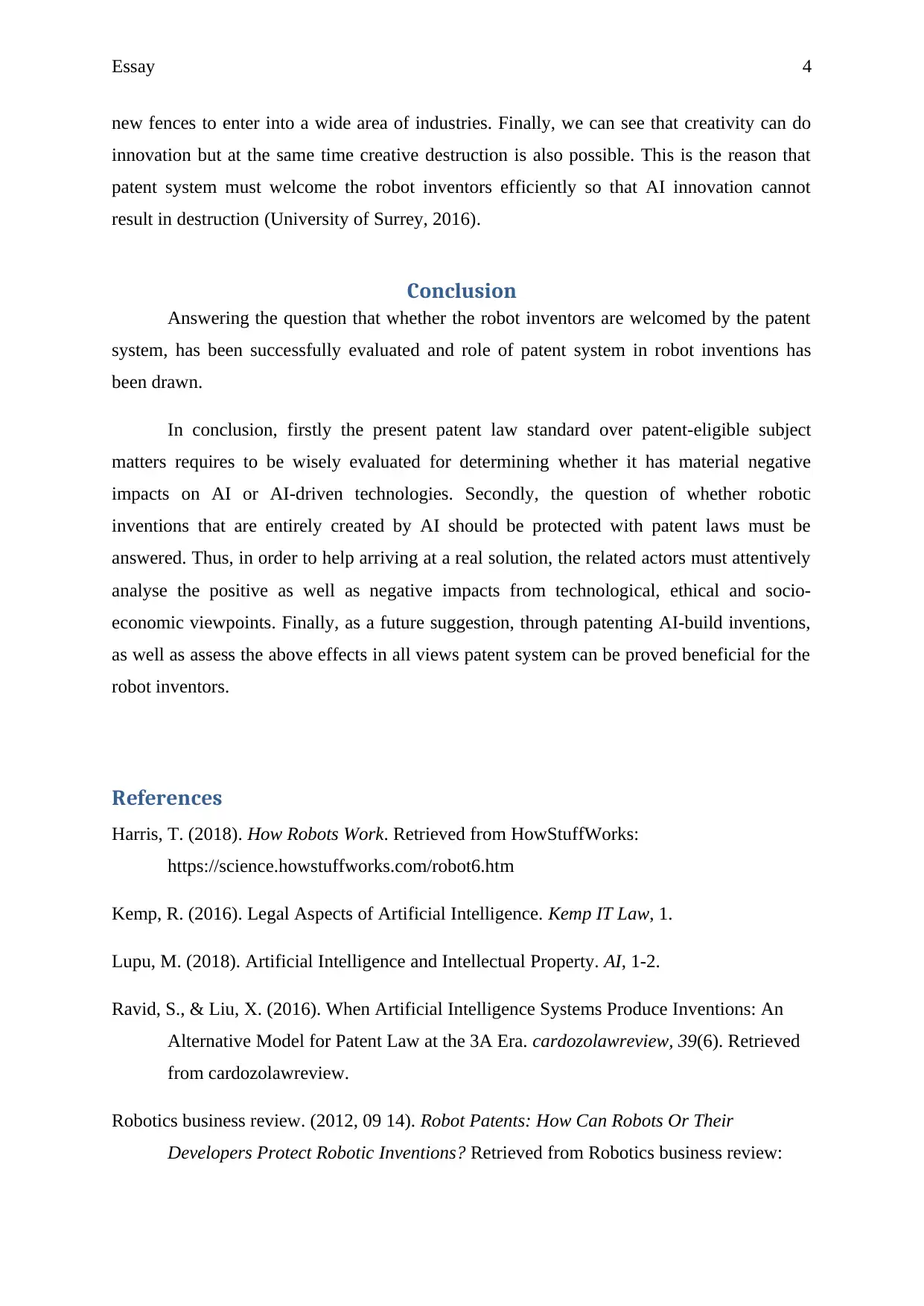
Essay 4
new fences to enter into a wide area of industries. Finally, we can see that creativity can do
innovation but at the same time creative destruction is also possible. This is the reason that
patent system must welcome the robot inventors efficiently so that AI innovation cannot
result in destruction (University of Surrey, 2016).
Conclusion
Answering the question that whether the robot inventors are welcomed by the patent
system, has been successfully evaluated and role of patent system in robot inventions has
been drawn.
In conclusion, firstly the present patent law standard over patent-eligible subject
matters requires to be wisely evaluated for determining whether it has material negative
impacts on AI or AI-driven technologies. Secondly, the question of whether robotic
inventions that are entirely created by AI should be protected with patent laws must be
answered. Thus, in order to help arriving at a real solution, the related actors must attentively
analyse the positive as well as negative impacts from technological, ethical and socio-
economic viewpoints. Finally, as a future suggestion, through patenting AI-build inventions,
as well as assess the above effects in all views patent system can be proved beneficial for the
robot inventors.
References
Harris, T. (2018). How Robots Work. Retrieved from HowStuffWorks:
https://science.howstuffworks.com/robot6.htm
Kemp, R. (2016). Legal Aspects of Artificial Intelligence. Kemp IT Law, 1.
Lupu, M. (2018). Artificial Intelligence and Intellectual Property. AI, 1-2.
Ravid, S., & Liu, X. (2016). When Artificial Intelligence Systems Produce Inventions: An
Alternative Model for Patent Law at the 3A Era. cardozolawreview, 39(6). Retrieved
from cardozolawreview.
Robotics business review. (2012, 09 14). Robot Patents: How Can Robots Or Their
Developers Protect Robotic Inventions? Retrieved from Robotics business review:
new fences to enter into a wide area of industries. Finally, we can see that creativity can do
innovation but at the same time creative destruction is also possible. This is the reason that
patent system must welcome the robot inventors efficiently so that AI innovation cannot
result in destruction (University of Surrey, 2016).
Conclusion
Answering the question that whether the robot inventors are welcomed by the patent
system, has been successfully evaluated and role of patent system in robot inventions has
been drawn.
In conclusion, firstly the present patent law standard over patent-eligible subject
matters requires to be wisely evaluated for determining whether it has material negative
impacts on AI or AI-driven technologies. Secondly, the question of whether robotic
inventions that are entirely created by AI should be protected with patent laws must be
answered. Thus, in order to help arriving at a real solution, the related actors must attentively
analyse the positive as well as negative impacts from technological, ethical and socio-
economic viewpoints. Finally, as a future suggestion, through patenting AI-build inventions,
as well as assess the above effects in all views patent system can be proved beneficial for the
robot inventors.
References
Harris, T. (2018). How Robots Work. Retrieved from HowStuffWorks:
https://science.howstuffworks.com/robot6.htm
Kemp, R. (2016). Legal Aspects of Artificial Intelligence. Kemp IT Law, 1.
Lupu, M. (2018). Artificial Intelligence and Intellectual Property. AI, 1-2.
Ravid, S., & Liu, X. (2016). When Artificial Intelligence Systems Produce Inventions: An
Alternative Model for Patent Law at the 3A Era. cardozolawreview, 39(6). Retrieved
from cardozolawreview.
Robotics business review. (2012, 09 14). Robot Patents: How Can Robots Or Their
Developers Protect Robotic Inventions? Retrieved from Robotics business review:
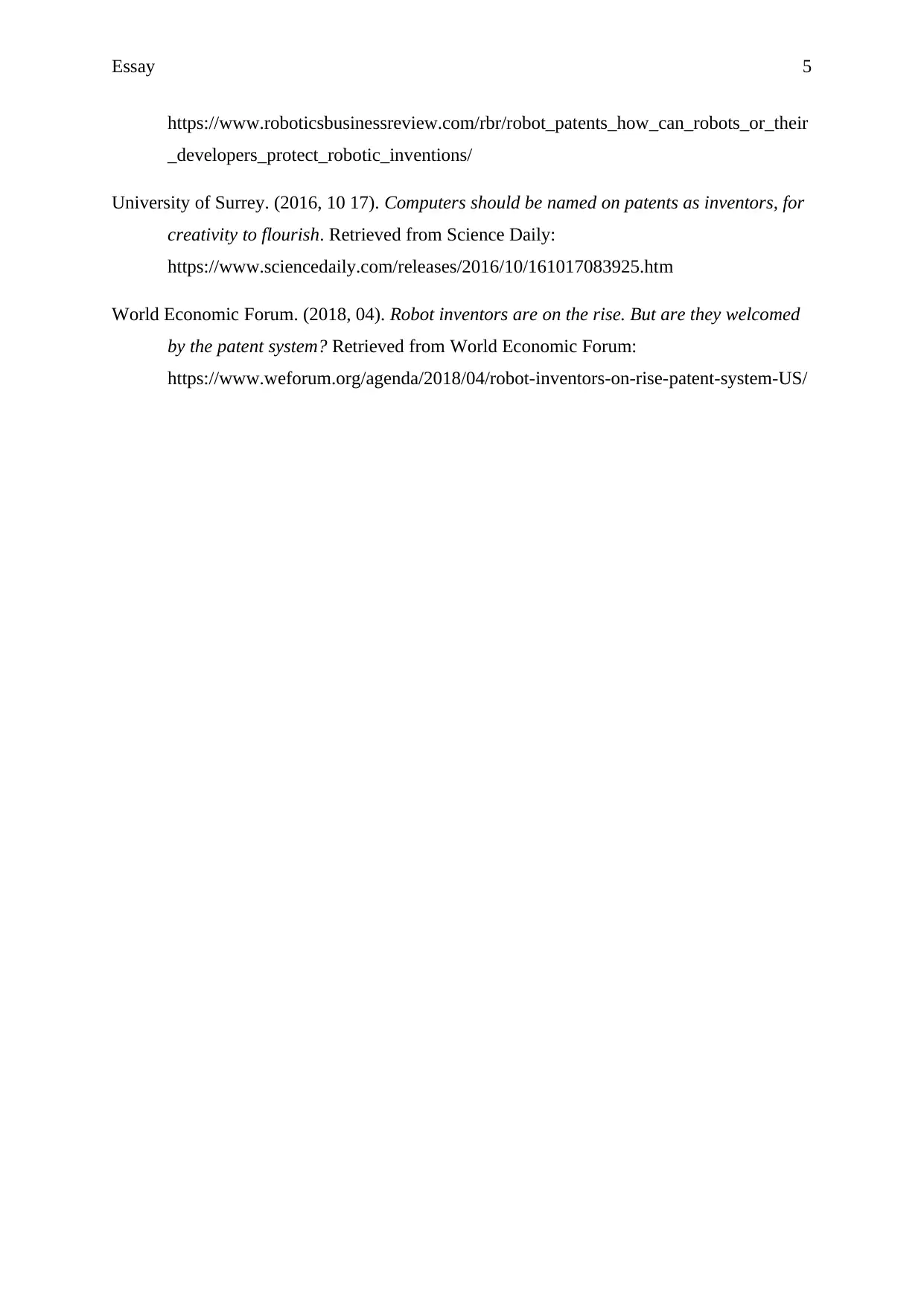
Essay 5
https://www.roboticsbusinessreview.com/rbr/robot_patents_how_can_robots_or_their
_developers_protect_robotic_inventions/
University of Surrey. (2016, 10 17). Computers should be named on patents as inventors, for
creativity to flourish. Retrieved from Science Daily:
https://www.sciencedaily.com/releases/2016/10/161017083925.htm
World Economic Forum. (2018, 04). Robot inventors are on the rise. But are they welcomed
by the patent system? Retrieved from World Economic Forum:
https://www.weforum.org/agenda/2018/04/robot-inventors-on-rise-patent-system-US/
https://www.roboticsbusinessreview.com/rbr/robot_patents_how_can_robots_or_their
_developers_protect_robotic_inventions/
University of Surrey. (2016, 10 17). Computers should be named on patents as inventors, for
creativity to flourish. Retrieved from Science Daily:
https://www.sciencedaily.com/releases/2016/10/161017083925.htm
World Economic Forum. (2018, 04). Robot inventors are on the rise. But are they welcomed
by the patent system? Retrieved from World Economic Forum:
https://www.weforum.org/agenda/2018/04/robot-inventors-on-rise-patent-system-US/
⊘ This is a preview!⊘
Do you want full access?
Subscribe today to unlock all pages.

Trusted by 1+ million students worldwide
1 out of 6
Related Documents
Your All-in-One AI-Powered Toolkit for Academic Success.
+13062052269
info@desklib.com
Available 24*7 on WhatsApp / Email
![[object Object]](/_next/static/media/star-bottom.7253800d.svg)
Unlock your academic potential
Copyright © 2020–2025 A2Z Services. All Rights Reserved. Developed and managed by ZUCOL.





